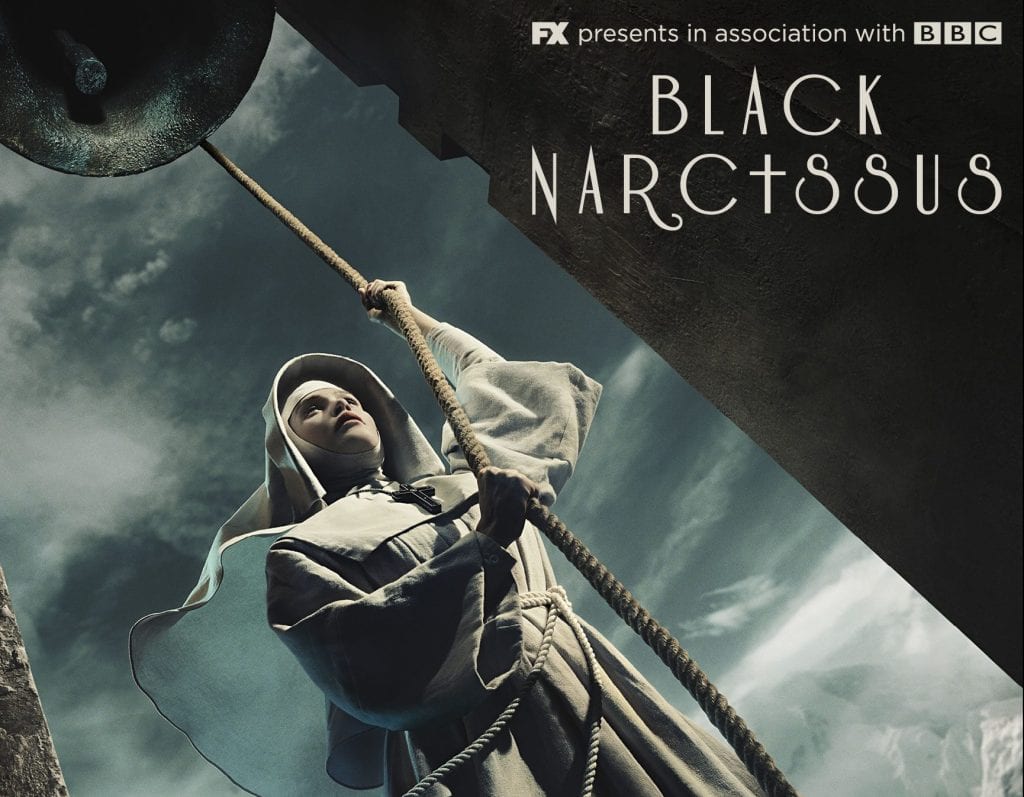This review contains spoilers
First a book, then a film, and now a TV show. Black Narcissus follows a group of nuns, headed by Sister Clodagh (Gemma Arton), who journey to a palace in the Himalayas to implement “education and enlightenment” for the ‘natives’. In the mountains, they encounter the handsome Mr. Dean (Alessandro Nivola) and the General’s teenage son, Dilip Rai (Chaneil Kunar). However, their endeavour comes with compromise when Dilip Rai is admitted to the school and Mr. Dean spends more time with the nuns. The gorgeous environment and the equally alluring Mr. Dean presents a challenge to the nuns and their values. Amongst this subtle corruption, Black Narcissus might just be alluding to a useful lesson about colonialism but, like the nuns and their school, it is without success.
As Sister Clodadagh sets off she is reminded that “Mopu is a wild place”. Mopu is the only view of India we get – a haunted decrepit palace occupied by British nuns. The nuns’ lens is our sole lens, so their interpretation of the palace and, by extension, India is the only one we get. Because we do not have any other perspectives, their view of India, as the wild, untamable palace, haunted by unseen forces becomes the only one that matters.
The former incarnation of the palace as a brothel haunts (no pun intended) the nuns. Erotic paintings on the wall contrast the location’s former function with its current incarnation. The palace covered in sarees and sexual paintings distill in it the Orientalist idea that the Orient (defined usually as any country of the East) was defined by disorganisation, sensuality, and bright colours. This is our only glimpse of a ‘native’ environment – implying that this is the only definition of the ‘native’ that matters. The idea of the ‘exotic’, the ‘untamable’, and the ‘sensual’ extends to the non-white characters like Kanchi (Dipika Kunwar) and Dilip Rai – local characters are only presented as sensual or uneducated.
Kanchi, despite appearing multiple times, is a 2-dimensional character. Her affair with Dilip Rai seems to come out of nowhere. A student who joins the classes for weaving, her backstory is bare and provided wholly by the white characters. Her biggest demonstration of agency seems to be in a sexual situation – her affair with Dilip Rai – once again reinforcing the idea of India and Indians as sexual. She has little substance and we are given no insight into either her education from the nuns or her affair with Dilip Rai.
The discovery of the affair is the turning point of the show – it precedes Sister Ruth’s (Aisling Franciosi) descent into madness, Sister Clodagh’s realisation that she has been too prideful, and the eventual departure of the nuns. The use of it as a plot device and character development moment for the white characters whilst not addressing the full impact on the local characters feels typical of British colonial dramas, using ‘native’ side characters as plot devices.
This is also true of Dilip Rai. His function in the plot seems to serve as a comparison with Mr. Dean to highlight the difference between western masculinity and ‘oriental’ masculinity. Dilip’s use of the perfume Black Narcissus, which the film was named for, seems to emphasise his femininity and frivolity which is contrasted with the manly, western ruggedness of Mr. Dean. This contrast is felt the most when, upon discovery of Kanchi and Dilip Rai together, the General has Dilip strike Kanchi three times. Mr. Dean does everything to try to dissuade the General, eventually looking away, unable to bear the beating of the girl. The scene seems to emphasise the brutality of the ‘natives’ and how they treat women, in direct contrast with ‘proper’ Western sensibilities.
Throughout the show we are introduced to numerous ‘native’ characters – Dilip Rai, Ango Ayah, the caretaker, Kanchi, and many of the villagers yet none of them occupy any role beyond illustrating the white characters’ reservations, desires, and troubles. Black Narcissus attempts to draw an underlying comparison between the work of the nuns and British colonialism. This is something that would have been incredibly poignant in 1947 when the film was first released, but today it misses the mark.
By focusing on the white characters we only get a white narrative – another colonial drama again revolving solely around the British. How can Black Narcissus illustrate the negatives of colonialism, when we only view everything through the white lens.
Words by Gurjinder Khambay
Support The Indiependent
We’re trying to raise £200 a month to help cover our operational costs. This includes our ‘Writer of the Month’ awards, where we recognise the amazing work produced by our contributor team. If you’ve enjoyed reading our site, we’d really appreciate it if you could donate to The Indiependent. Whether you can give £1 or £10, you’d be making a huge difference to our small team.

